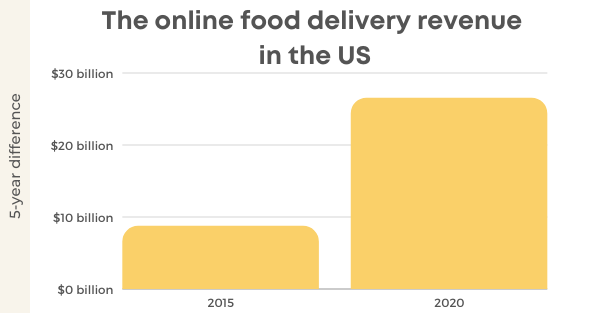Online food ordering and delivery is a growing trend for the last couple of years. Unlike other industries that suffer the negative impact of the COVID-19 pandemic, food delivery has never seen a higher revenue. With millions of users, this food segment is definitely blooming. And it will only bloom and grow more in the upcoming years.
How much is the food delivery industry worth? How many people use food delivery apps? How did the pandemic impact this entire market?
These and many more questions are answered in today’s article. We’ll cover all the segments of food ordering, delivery, apps, and more.
Keep on reading to find out everything there is about this popular trend!
10 Key Food Delivery Industry Statistics (Editor’s Pick)
- The online food delivery revenue in the US tripled in 5 years.
- Online ordering is growing 300% faster than in-house dining.
- In 2019, Americans spent $11 billion on pizza delivery.
- 31% of Americans use food delivery services more times a week.
- 53% of American adults stated that delivery services are essential.
- People are more likely to order food now than before COVID-19.
- 43% of people order food online because they don’t feel like cooking.
- 60% of Millennials order food to watch a movie, show, or series.
- 28% of delivery drivers sample the food they’re delivering.
- GrubHub is the most popular food delivery app.
38 Food Delivery Statistics
1. The global online food delivery market has an annual growth rate of 10.3%.
According to data provided by Cision, the global online food delivery services market was estimated to be worth $115.07 billion in 2020. The report stated that in 2021, the market should be worth up to $126.9 billion. That would be a compound annual growth rate (CAGR) of 10.3%. There is no doubt that due to the COVID-19 pandemic, there will be an even higher increase in 2022.
Source: Cision
2. The online food delivery revenue in the US tripled in 5 years.
In the United States, the online food delivery industry generated more than $26.5 billion in 2020. Back in 2015, 66 million Americans ordered $8.7 billion of food delivery. In 2020, that number tripled. The food delivery revenue surpassed $26 billion and 111 million users. 2021 and 2022 are estimated to have an even higher growth rate of food ordering and delivery.


Source: Fundera
3. Trend of online ordering is growing 300% faster than in-house dining.
According to Fundera data, online ordering is growing 300% faster than in-house dining. This trend started even before the pandemic, however, COVID-19 definitely speeded up its increase in popularity and worth. Food ordering is simply more convenient, safer, and easier during this time of the pandemic. However, there is no doubt that this trend will continue to grow even once the pandemic is over.
Source: Fundera
4. Chinese consumers generate the most revenue in this food segment.
Despite the belief that the US food delivery market is the biggest, Chinese consumers actually generate the most revenue. In 2019, China had a revenue of 579 billion yuan. One year later, China’s market size of online food delivery services reached 664,62 billion yuan. That is $102 billion. However, China is often called out due to concerns about the country’s labor malpractices and environmental impact.
Source: Statista
5. From 2019 to 2020, there was a 17% increase in the number of Americans who used food delivery services.
The data provided by Fundera stated that more than 112 million Americans tried and used a food delivery service in 2020. That is a 17% increase from the previous 2019. This trend is very popular and it is sure that its popularity will only grow more in the upcoming years.
Source: Fundera
6. About 60% of Americans order food delivery or takeout at least once a week.
Americans do love to order food online. However, it is shocking to see that more than half of Americans order takeout or delivery once or more times a week. That is a promising trend for food delivery services, but a bad habit for American consumers. This trend is both expensive and unhealthy. Especially when we’re talking about fast food meals.
Source: Fundera
7. Americans spent billions of dollars on ordering pizza.
According to data by Comfy Living, US consumers love their pizza. In 2019, Americans spent $11 billion on pizza delivery. What is interesting is the fact that pizza is guilty of more than 80% of overweight problems. Fried chicken is in second place and sandwiches in third. However, some pizzas may be a bit healthier than others. For example, cauliflower pizza rose to 650% in popularity in 2019.


Source: Comfy Living and JMPH
8. People spend up to 18% more on ordering pizza online or through mobile apps.
Speaking of pizza, the Upserve report stated that there was an 18% increase in customer spendings on online or mobile pizza orders versus phone orders. Pizza is already a rather popular order, however, the convenience of ordering such a meal using only a website or mobile app makes it easier to spend more than you were planning to.
Source: Upserve
9. Sandwiches and wraps had a 21% increase in sales in 2020.
The most popular food that increased online sales in 2020 in the United States was sandwiches and wraps. Their sale went up by 21%. In second place are burgers with an increase of 10%, and pizza is in third place with a 9% increase in sales.
Source: Upserve
10. More than 30% of Americans use third-party food delivery services on a weekly basis.
Speaking of American consumers, 31% of them use third-party food delivery services twice or more times a week. Such services ease up the food ordering and delivery, however, they take a certain fee for delivery and tip, so people tend to pay a lot more than when picking up a takeout food or simply dining in the restaurant.
Source: Fundera
11. About 12% of Americans order up to $75 worth of food.
According to data by Statista, 34% of Americans don’t order food more expensive than $50. The data stated that 26% of Americans order food below $25, while 12% of them order up to $75 worth of food. That is a huge amount of money spent only on one meal. And that cost is without the fees of delivery and tip.
Source: Statista
12. Almost 60% of Millennials’ orders are for takeout or delivery.
Millennials love to use technology, especially regarding online food orders and delivery. According to data provided by Fundera, 59% of restaurant orders made by Millennials are for takeout or delivery. This isn’t a surprise since Millennials do love and tend to be at the forefront of trends.
Source: Fundera
13. More than 50% of adults think that takeout and delivery services are essential for their life.
Toast provided data and statistics about the growing trend of food ordering and delivery. And according to that, such trend has become a part of everyone’s lives. 53% of the American adults stated that delivery services and takeout are essential. 64% of Millennials thought the same, as they said that food delivery and takeout are essential to the way they live.


Source: Toast
14. Most people order food because they don’t want to leave their house.
According to the data provided by Mintel, 56% of the consumers order food so that they don’t have to leave their home. This is a good and safe action during these days of the pandemic, however, once it is over if consumers continue to avoid getting out of the house, that can harm their social abilities.
Source: Mintel
15. People are more likely to order food now than before COVID-19.
COVID-19 pandemic has definitely had an impact on the online food order market. But unlike the other markets on which pandemic influenced in a negative way, the online food order market bloomed. And it is still blooming. According to the Toast data, 6 out of 10 adults were more likely to get their food delivered now than before COVID. When it comes to Millennials, the number is even higher – 71% of them are likely to order food online now.
Source: Toast
16. During the pandemic, the number of food delivery app users will grow by millions.
As we said, the pandemic has massively impacted everyone’s lives. During these times, people are reaching out to convenient and safe ways of getting everything they need. The same goes for food. According to Statista, it is predicted that there will be a high growth of people using food delivery apps. It is estimated that the number of users in the US will increase to 45.6 million during the pandemic.
Source: Statista
17. People are willing to pay more for faster delivery.
When it comes to online food ordering and delivery, there are some issues that are considered to be negative. For example, the speed of the delivery. Sometimes, you just can’t control the traffic or the rush hour in the restaurant you ordered from. And due to that, time and speed of delivery can be negative factors. According to Fundera, 33% of consumers would pay more to ensure they get their food faster. With that in mind, it is clear that fees for using online platforms for ordering aren’t a significant deterrent for most consumers.


Source: Fundera
18. Using third-party delivery services is beneficial for the restaurant.
Despite the fact that 43% of restaurant professionals don’t like third-party delivery services (they feel that such platforms interfere with a direct relationship between them and the consumers), working with a third-party delivery service can actually be very beneficial to the restaurant. According to Fundera, using such services raises restaurant sales volume by 10% to 20%.
Source: Fundera and Lunchbox
19. Almost 60% of people have a third-party delivery app.
Speaking of third-party delivery services, 57% of people actually have such food delivery apps. Those platforms ease up the ordering process and make a restaurant more attractive to a larger swath of the population. Besides, they get a lot more reach of customers on third-party delivery platforms.
Source: Lunchbox
20. About 46% of people don’t know what meal to order so they use an online food delivery app for inspiration.
According to the data provided by US Foods, the average person has 2 food delivery apps and uses them up to 3 times per month. The data states that 54% of people start using the app with a restaurant in mind and then they look for it in the app. 46% of people start by opening an app and then look for ideas in what order.
Source: US Foods
21. People are more likely to visit the restaurant once they started online ordering from there.
One of the best benefits of offering online ordering is existing online, not only in the real streets. According to Fundera, customers who place online orders are more likely to visit that restaurant in person too. Also, such people are more likely to order food again through the online platform. The data stated that those people who place an online order will visit that restaurant 67% more often than those who don’t.
Source: Fundera
22. More than 40% of people order food because they don’t feel like cooking.
There are many reasons why people order food online. Some of them don’t have time to cook, they have too many duties, or children don’t want to leave them alone. However, Statista stated that 43% of people order food online because they don’t feel like cooking. Laziness can be a big problem when it comes to eating the right and nutritious food.


Source: Statista
23. Half of the people order food on the phone.
For most people, ordering food online is easier, simpler, and more convenient. And according to data provided by Toast, 52% of people order takeout on the phone. Technology is developing on a daily basis and people have it all in those small mobile phones. As it is often said, everything is in the palm of your hand.
Source: Toast
24. Millennials love to eat and watch movies.
Watching a movie or a TV show is a perfect time for snacking or having a meal. According to data by Mintel, 60% of Millennials stated they have restaurant food delivered to watch a movie, show, or series. With a lot of streaming platforms in the world, there are many movies to watch – due to that, there are many options for meals and snacks too.
Source: Mintel
25. China’s food delivery apps reach over 650 million people.
There are many food delivery apps and according to Business of Apps and their data, China’s food delivery apps have the largest userbase and market penetration. Such apps reach over 650 million people there. The second-largest market is the United States. The US market is also the most well funded.
Source: Business of Apps
26. GrubHub, Uber Eats, and DoorDash account for 70% of the US market share in food delivery.
Data by Statista states that the current US industry leader in online food delivery is GrubHub. From 2018, GrubHub holds 34% of the market share in the United States. In second place is Uber Eats with 27% of the market share. In third place is DoorDash. Altogether, these companies account for 70% of the market share in food delivery.


Source: Statista
27. US market revenue in food delivery has increased by more than 200% in 5 years.
Between 2015 and 2020, US market revenue in food delivery has increased by 204%. Platform-to-customer services such as Postmates, or the already mentioned Uber Eats and DoorDash, are able to provide a wider selection of restaurants and food types, and thanks to that, the market had a high increase in popularity, usage, and revenue. And an increase of 204% is a massive growth in only 5 years time period.
Source: Business of Apps
28. Almost 30% of delivery drivers sample the food they’re delivering.
We already mentioned the problem of speed regarding food delivery. But did you know that 28% of delivery drivers sample the food while delivering someone’s order? Unprofessional workers are a big problem in this industry. With thousands and thousands of employees, professionalism should be in the first place of job requirements. But then again, no one can control them when they’re on the road.
Source: U.S. Food Corp.
29. Third-party delivery apps make life easier for almost 90% of people.
We talked about the advantages of using third-party delivery apps – they are convenient, easy to use, and safer during this ongoing COVID-19 pandemic. According to data provided by Omni Experience, 87% of people stated that such apps make their life easier.
Source: Omni Experience
30. Women use GrubHub more than men.
GrubHub is the most popular food delivery app. According to its user base, 64.3% of it are women, while only 35.7% are male users. When it comes to age, there is a tie between 25-34 and 35-44. Both groups make up 32.3% of GrubHub’s users. The age group of people using the app the least is 18-24.
Source: Verto
31. Most GrubHub orders in 2019 were healthier.
The study made by GrubHub showed that a majority of top foods that are ordered in 2019 are comprised of vegetarian or vegan-friendly options. It is great to hear that even though people are ordering food, they actually do care about what they’re consuming on a daily basis. They could easily go for fast food or some other type of unhealthy food.
Source: Food Navigato
32. About 63% of Millennials and Gen Zers use food delivery apps.
If we look at the entire market of food delivery apps, not only GrubHub, Millennials and Gen Zers are most likely to use such apps. According to Toast data, 63% of individuals who are 18 to 29 years old, stated that they’ve used a website or a delivery app in the last three months. However, due to the ongoing COVID-19 pandemic, there is no doubt that the usage of such apps has become more frequent.
Source: Toast
33. Postmates charges the most in fees.
All those delivery apps and services such as GrubHub, Uber Eats, DoorDash, and Postames, charge additional fees for their services. According to the study conducted by Kinetic 12, GrubHub charged the lowest – only 12% in fees. In second place was Uber Eats with 20% in fees, while in third place was DoorDash with 21% in fees. Postmates was fourth with 30% charges in fees. That is more than double GrubHub’s 12%.
Source: Kinetic 12
34. Uber Eats delivers food the fastest.
We already mentioned how important is the speed of food delivery. QSR Magazine reported on the study where consumers measured the time it took each delivery service to arrive with their order. Uber Eats was the fastest. Its average arrival time was 35 minutes and 31 seconds. In second place was Postmates with an average arrival time of 40 minutes and 12 seconds. DoorDash was third with 42 minutes and 1 second, while in fourth place was GrubHub. This delivery was the slowest and it took 50 minutes and 22 seconds for the company to deliver the order.
Source: QSR Magazine
35. Online food ordering market is estimated to increase by more than 12%.
With the still ongoing COVID-19 pandemic, it is estimated that the online food ordering market will have an increase in popularity and revenue. According to data by Toast, it is projected that the revenue will increase by 12.2%. Due to that, it is important for a restaurant to offer a possibility of online ordering and delivery, especially during these days of the pandemic.


Source: Toast
36. Food delivery apps will have almost 10 million more users by 2023.
The growth of food delivery apps is expected to continue. According to data by Statista, is estimated that such apps will have 53.9 million users in the United States by 2023. That would be almost 10 million more users than in 2021. Quite a high growth in only 2 year period.
Source: Statista
37. By 2025, there will be 164 million users of online food delivery.
Speaking of increases and growth rates, the online food delivery segment won’t only have an increase in its revenue but also in the number of users and consumers. According to data provided by Statista, by 2025, this segment will have 164 million users. Convenience will definitely be one of the contributing factors to that increase.
Source: Statista
38. Online food ordering segment is a rapidly growing trend.
With the growing number of users, it is expected that the online food ordering segment will be worth $200 billion. This rapidly growing trend is changing the entire global food industry, especially the restaurant industry. And it will take years for the online food ordering trend to actually reach its peak.
Source: Frost & Sullivan
To Wrap It Up
Online food ordering and delivery is definitely a growing trend. Despite their already high revenue and popularity, both of these factors will see a massive growth rate in the upcoming years. People are looking for a convenient and easy way of getting food, and online food delivery is giving them what they need. Besides, with the ongoing pandemic, there is truly no safer way of getting everything with a simple click on the mobile app.


















Leave a Reply